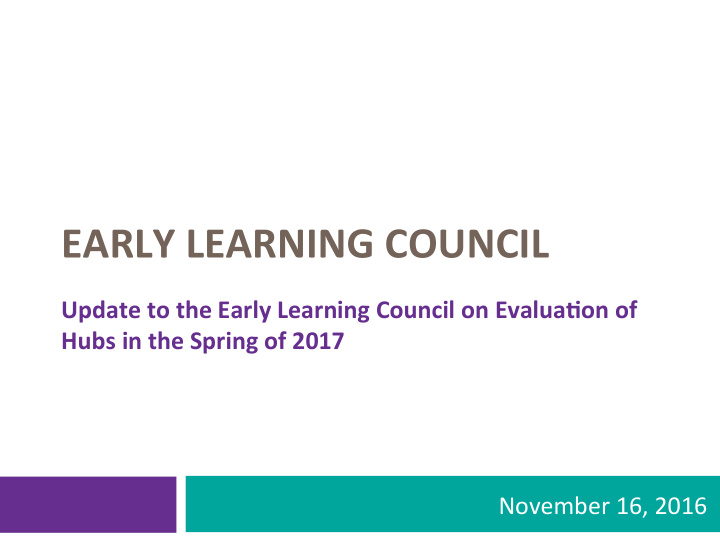



EARLY LEARNING COUNCIL Update to the Early Learning Council on Evalua=on of Hubs in the Spring of 2017 November 16, 2016
Purpose 2 1. Assure that hubs are: � Developing effec?ve collabora?ve systems in their regions � Inves?ng strategically, and in priority popula?ons � Showing progress on outcomes related to the Early Learning System’s three main goals 2. Iden?fy any necessary correc?ons or adjustments early in the development of the system 3. Ins?tute a culture of Con?nuous Quality Improvement across the system
Guiding Principles 3 Intended to guide development of evalua?on tools and processes that support mutual learning, con?nuous improvement and capacity-building across the hub system. • Evaluation Process Builds Capacity of • Accountability is Transparent Hubs and System • Data collected focused on continuous quality • Mutual Learning and Dialogue improvement • Focus on equity is apparent • Findings are based on evidence • Strengthens partnership between • Opportunities for self-reflection and . regional and state systems partnership building
Background 4 � Mul?-year system evalua?on will begin in early 2017. This is different than the hub monitoring process outlined in this presenta?on. � Evalua?on of the hubs was requested during the 2015 legisla?ve session. This is the focus of this presenta?on.
Three Components 5 Preparatory Partner Monitoring Visits Surveys Visits • Celebrating • Gaining more • Multiple pieces of Successes knowledge about evidence paint full • Preparing for hub success from picture of hub • Self-reflection Monitoring Visit regional partners • Tout successes • Identify next steps for continued improvement
Hub Engagement and Prepara?ons 6 • Hubs help revise Indicators for Hub Success at site visits and August Learning Collaborative. Visits: • Hubs discuss Spring Monitoring Visits with ELD staff. July-Sept • Regional meetings/input sessions about survey and process. • Hub staff and partners surveyed about hub relationships and activities. Surveys: Nov - Feb • Hubs complete narrative questions and submit necessary documentation. • Monitoring site visits with each hub. Visits: • Hubs and ELD develop quality improvement next steps. Feb - May
Evidence 7 Hub Indicators for Success and Guiding Principles are the guiding documents for the evidence: � Documenta?on (Strategic and Work Plans, MOUs, etc) � Partner feedback (via Partner Survey) � Hub Narra?ve Ques?ons � Facilitator and Hub Team Observa?ons � Hub Self-Scoring of Monitoring Rubric � ELD scoring of Monitoring Rubric
Partner Survey (January 2017) 8 � Tailored for different stakeholders in community. � Hub will work with ELD hub team to iden?fy stakeholders to be interviewed. Sample (very dra_) ques?ons : � The Hub’s decision-making process, and my role in it, are clear to me. � I invest in the success of my hub (please describe). � My hub uBlizes the data available to them to develop strategies and guide their decisions. � I have influence over the direcBon of the Hub.
Monitoring Process 9 Prior to visit: Mutually Determine Phase of Hub Development 1. Review Monitoring Goals, Process, and Use of 2. Findings Reviewers and Hub Leaders Complete Narra?ve 3. Ques?ons and Self-Assessment
Sample Dra_ Narra?ve Ques?ons 10 � Since becoming a hub how have you become clearer on who the specific focus populaBons are? � How does your decision making process work for determining strategies, acBviBes and funding allocaBons? How are your partners and governance body involved? These will be submi`ed prior to the site visit.
Self-Assessment 11 2. Hub governance bodies are contributing members whose input and feedback is included in the decisions, actions and strategic investments of the hub. 0 1 2 3 0 1 2 3 Hub Evidence and Comments: ELD Evidence and Comments: The hubs and ELD will both fill out an assessment, and then compare responses.
Monitoring Process Con?nued... 12 During Monitoring Visit: Share and discuss the findings based on evidence. 4. Discuss and Document Next Steps for Con?nuous 5. Quality Improvement. ALer Monitoring Visit: Findings shared with ELC, including 6. recommenda?ons for quality improvement or any possible correc?ve ac?on.
Summary of Assessments 13 Overall Summary Hub Leaders Reviewers Total Rating Total Rating Process Indicators /9 /9 Productivity Indicators /18 /18 Essential Functioning Indicators /3 /3 Total Indicators Score /30 /30 Hub Evidence and Comments: ELD Evidence and Comments:
Discuss Next Steps for Quality Improvement 14 Hubs’ next steps for growth will naturally emerge from the process: � Monitoring is designed to lead to change, producing relevant, ac?on-oriented findings. � Evalua?on should strengthen the partnership between the ELD and hub system, guided by mul?ple opportuni?es for mutual learning and dialogue. � Evalua?on is both science and art.
ELD: Con?nuous Quality Improvement 15 � Looking for pa`erns and ways to support the system. � Iden?fy steps ELD can take to improve its support of hub success. � Con?nue to improve targeted technical assistance.
16 Thank you for the opportunity to share this developing process with the ELC!
Recommend
More recommend